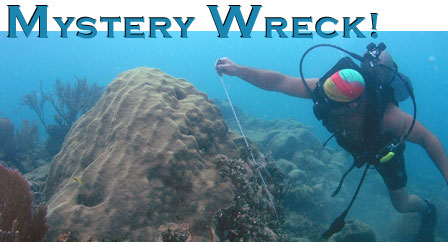
Archaeologists Hunt for Clues into Identity of a Centuries Old Florida Keys Shipwreck
Scientists from the National Marine Sanctuary Program, in a cooperative effort with State of Florida researchers, put on their detective hats for a recent expedition that set out to unravel the mystery of a shipwreck that has eluded identification for more than three decades.
Resting peacefully in the shallow waters of Florida Keys National Marine Sanctuary off the coast of Marathon, Fla., in an area dotted with vibrant patches of coral and the shadowy hulks of lost ships, the “mystery wreck” is thought to rank among the oldest known shipwrecks in the region.
Funded by a mini-grant through NOAA’s Maritime Heritage Program, state and federal archaeologists converged on the site from June 20-28, documenting the wreck for the first time since the sunken ship was discovered in the early 1970s and hunting for clues that may help shed light on its murky past.
The research team spent nine days surveying the wreck, making a detailed map of the area and recording every inch of it with still and video photography. Divers retrieved small samples of the hull and of a coral formation that had established itself on the exposed ballast pile of the ship, sending the specimens off to laboratories for further examination.
While no gold or jewels were discovered at the site, the mystery wreck is now home to a different kind of treasure. When it grounded and eventually sank on the patch reef where it now rests, it became incorporated into the reef and now hosts a teeming assortment of marine life.
“It’s a beautiful site, and almost totally unscathed,” said Brenda Altmeier, Florida Keys National Marine Sanctuary program support specialist. “When you mix biological significance with the site’s cultural value, that really encompasses what the Florida Keys sanctuary is.”
Roger Smith, state underwater archaeologist and principal investigator for the research mission, said researchers were surprised to find that the ship’s wooden hull seemed to be extraordinarily well-preserved—a rarity for shipwrecks in the warm, shallow waters of the Florida Keys, which tend to accelerate the decomposition process.
Analysis of the samples revealed the startling reason for the hull’s relatively pristine state: the material originally thought to be wood was actually concrete that had been poured into the spaces between the now-decomposed timbers of the hull.
“We were confused at first,” Smith said. “Then we realized that what we were looking at was essentially a negative of the hull. I’ve spent my whole adult life studying shipwrecks, and I’ve never seen one with this kind of construction.”
Based on a preliminary assessment of the expedition’s findings, archaeologists believe that the wreck was likely a small 17th-century Spanish vessel—possibly a messenger ship or scout—which would make it more than 300 years old. The ship, which ran aground on one of the area’s many patch reefs, was probably salvaged of all valuable equipment before it sank.
Bruce Terrell, senior archaeologist for the National Marine Sanctuary Program, said a treasure hunting expedition scoured the wreck for valuables in 1972, but found only a handful of cannon and musket balls and pottery shards that have been dated to the early 1600s.
Altmeier said the valuable cooperation between the participating agencies and the ideal weather conditions resulted in a highly successful mission.
“It was great opportunity for the sanctuary program and the State of Florida to work together,” Altmeier said. “It’s tremendous for us because it lays some groundwork down and it turned out to be a great expedition for everyone involved.”
While there is currently no final word on the vessel’s identity, researchers will continue to study the expedition’s findings in the months to come in the search for further clues.
|





